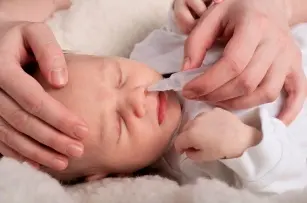
The nasal passages in infants are very narrow, so in their case the usual runny nose becomes a serious problem. If neglected, it can cause various complications, such as ear and sinusitis. It is not made easier by the fact that children up to the age of one breathe only through their noses. This inconspicuous organ is very important – it acts as an air conditioner and filter, because it regulates air humidity, removes impurities and at the same time warms it. Babies breathe as much as 50 times a minute, which is why nasal obstruction in such a baby is often a real problem. That is why it is worth knowing how to get rid of a runny nose quickly and effectively!
When a baby cannot breathe, there are many problems: it sleeps worse, is irritable, there are difficulties with feeding because the baby stops sucking to get air, sometimes there are other complications such as inflammation of the paranasal sinuses or earache.
Chronic rhinitis, i.e. lasting an exceptionally long time, contributes to breathing disorders known as “wheeze”. We will recognize it by the child’s constantly open mouth and dilated nostrils. Since the infant cannot clear the nose on its own, and the only relief comes from crying, during which tears dissolve the dried secretion, parents step in. Here’s what you can do for your little one’s nose:
- Clean your baby’s nose with an aspirator. It is usually tubular in shape. How to use it: insert its narrower end into the nose, put a special tube on the other end through which you will suck in air. In this way, you will draw secretions from the nose – thanks to a strong draft of air. The aspirators contain a ball of cotton wool or a special sponge filter that prevents secretions from entering the tube. After use, wash the tip that you put in the baby’s nose so as not to transfer bacteria there.
- When the baby is not sleeping, put him on his stomach, then the secretion will spontaneously flow out of the nose.
- Be sure to humidify the air in the room where the child is staying, because if it is too dry, it will aggravate the runny nose as a result of drying the mucous membranes. If you don’t have a special humidifier, put a wet towel on the radiator.
- When your baby is sleeping, his head should be higher than his chest. To do this, put a pillow or blanket under the mattress, you can also put something under the legs of the cot so that it is slightly raised. In the case of babies who have not yet mastered turning over on their back and stomach on their own, a pillow should not be placed directly under the head, so as not to tire the spine and not force an unnatural position.
- Use inhalations, i.e. add essential oils (recommended by a pediatrician) or chamomile to hot water in a bowl or pot, then put the child on your lap and put his chin under the vessel – in such a way that the steam does not burn him. Sometimes inhalations can be carried out using an air humidifier, if the manufacturer allows it.
- Use sea salt sprays. Applying it to the nose will dissolve the residual secretion, which you will then remove with a tissue rolled into a roll or with an aspirator.
- For this purpose, saline will also work: pour one or two drops of salt into each nostril, then wait a moment until it dissolves the secretion and remove it.
- You can also give your child special nasal drops, but to do this, consult your pediatrician, as they can irritate the mucous membranes.
- If the child is more than six months old, you can lubricate his back and chest with an ointment with a volatile substance that will reduce mucosal congestion.
- Marjoram ointment, which is applied to the skin under the nose, will also be good, but be careful to apply a little bit of it and be careful not to let it get into the nose, as it can cause irritation of the mucous membrane.









